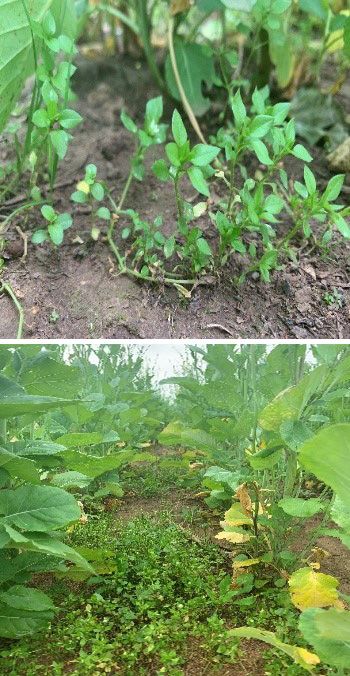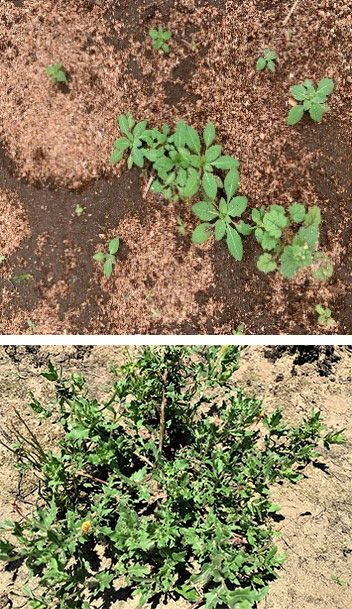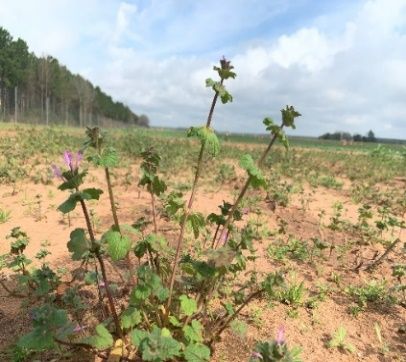Winter Weed Emergence during Carinata (Brassica carinata) Production
This publication is targeted to county UF/IFAS Extension agents and growers to provide an overview of winter weed emergence timing in relation to the cumulative growing degree days (GDD) and carinata (Brassica carinata) growth stages in Florida. The information presented is a summary of research conducted at the UF/IFAS West Florida Research and Education Center in Jay, FL. This publication provides information for predicting emergence timing of common winter weed species for carinata production and will aid in implementing control measures in a timely manner.
Background
Recently, carinata has been promoted as an oilseed crop for biofuel production. In the southeastern United States, carinata is planted in late fall, grown throughout the winter, and harvested the following year in late spring to early summer (Seepaul et al. 2019). Multiple winter weed species can be a problem during carinata production. Chickweed (Stellaria media) is a common winter weed, which is widely distributed throughout the southeastern United States. It emerges throughout the winter season from late fall to early spring (Figure 1). Likewise, cutleaf evening-primrose (Oenothera laciniata) (Figure 2) and henbit (Lamium amplexicaule) (Figure 3) are two more problematic winter annual weeds for cool-season crops in the southeastern United States. (Webster and MacDonald 2001).

Credit: Ruby Tiwari

Credit: Ruby Tiwari and Pratap Devkota

Credit: Ruby Tiwari
Carinata exhibits slow early-season growth; therefore, weed control measures during early crop growth are necessary to prevent yield loss. Prediction of the timing of weed emergence in relation to critical crop growth stages is important for weed control. Environmental conditions such as temperature influence weed emergence timing; thus, temperature should be considered for planning and implementing weed management strategies (Hill et al. 2014). Emergence of weed species is commonly described using accumulated GDD. The GDD, also known as heat units, incorporates the average daily temperature accumulation by a crop or weed species. It is widely used and is a more reliable method than days after planting for estimating emergence and development stages of crops and weeds. For weeds, GDD is particularly important for determining emergence thresholds (percent) and implementing control strategies in a timely manner.
Winter Weed Emergence and Carinata Growth Stages
Winter weed emergence patterns were determined through carinata research during the 2019–2020 season at the UF/IFAS West Florida Research and Education Center in Jay, FL. Cumulative emergence for the winter weed species (chickweed, cutleaf evening-primrose, and henbit) were calculated as a percent of total emergence. Weed emergence was described using cumulative growing degree days (GDD):

where represents the daily average soil temperature in degrees Celsius (oC), and is the minimum temperature at which chickweed, cutleaf evening-primrose, and henbit seeds germinate. Base temperatures of 10oC for chickweed and 0oC for cutleaf evening-primrose and henbit were used for GDD calculation. For carinata GDD calculation, 5oC was used as the base temperature (i.e., based on winter canola) and important growth stages were recorded.
Cumulative GDD and Winter Weed Emergence
Total chickweed emergence was 25% at 100 GDD (Table 1) and 50% at 250 GDD. Cumulative GDD was 350–400 for chickweed at 75% emergence, while GDD was about double that for 100% emergence. For cutleaf evening-primrose and henbit, GDDs were nearly double that of chickweed for the same level of emergence (Table 1). These two weed species showed 25%, 50%, and 90% emergence at 250, 500–700, and 1,000–1,200 GDD, respectively. Henbit and cutleaf evening-primrose showed 100% emergence after 1,300 GDD.
Table 1. Winter weed emergence (%) predicted by cumulative growing degree days (GDD) during carinata production in Jay, FL.
Cumulative GDD and Carinata Growth Stages
Carinata reached the 2- to 3-leaf stage at 200 GDD (Table 2) and the 4- to 5-leaf stage at 400 GDD. After the 4- to 5-leaf stage, however, carinata required only an additional 100 GDD (i.e., cumulative GDD of 500) to reach the 8- to 10-leaf stage. Early bolting occurred at 750 GDD. At 1,000 GDD, carinata reached 50% flowering, and pod fill to maturity occurred at 1,300–2,000 GDD.
Table 2. Carinata growth stages corresponding to cumulative growing degree days (GDD) during carinata production in Jay, FL.
Winter Weed Emergence in Relation to Carinata Growth Stage
Chickweed emergence was 50% when carinata was approximately at the 2- to 3-leaf stage (Table 3). About 75% of total chickweed emergence occurred by the time carinata was at the 4- to 5-leaf stage. The remaining 25% of the total emergence occurred when carinata was between the 5- to 6-leaf stage through early bolting. The emergence of cutleaf evening-primrose and henbit was only 25% when carinata reached the 4-leaf stage (Table 3). These two weed species reached 50% and 75% emergence when carinata was at the 10- to 12-leaf stage through late bolting, respectively. For these weed species, 90% of emergence occurred by 50% flowering of carinata.
Crop growth stage is an important aspect to consider when implementing weed control. Spring canola, botanically similar to carinata, should be kept weed-free until the 4- to 6-leaf stage in order to prevent yield loss (Martin et al. 2001). Our results illustrated that the majority of chickweed emergence occurred during early carinata growth, whereas the majority of cutleaf evening-primrose and henbit emergence occurred between the late vegetative to early flowering stages of carinata. Therefore, it is recommended to implement chickweed control measures during early carinata growth (i.e., by the 4- to 6-leaf stage). Likewise, cutleaf evening-primrose and henbit should be managed prior to carinata flowering, not only for improved control but also because of field access. Moreover, effective control strategies need to be implemented with appropriate timing to control these as well as other problematic weed species.
Table 3. Winter weed emergence in relation to carinata growth stage at Jay, FL.
Conclusion
Carinata growers need to consider timing for optimal winter weed control. The relationship between GDD, winter weed emergence, and carinata growth should be considered as part of an integrated weed management program. Utilize appropriate herbicide programs or other tools to control weeds in a timely manner to prevent weed competition at critical crop growth stages.
References
Hill, E. C., K. A. Renner, and C. L. Sprague. 2014. “Henbit (Lamium amplexicaule), Common Chickweed (Stellaria media), Shepherd’s Purse (Capsella bursa-pastoris), and Field Pennycress (Thlaspi arvense): Fecundity, Seed Dispersal, Dormancy, and Emergence.” Weed Science 62:97–106. https://doi.org/10.1614/WS-D-13-00074.1
Martin, S. G., R. C. Van Acker, and L. F. Friesen. 2001. “Critical Period of Weed Control in Spring Canola.” Weed Science 49:326–333. https://doi.org/10.1614/0043-1745(2001)049[0326:CPOWCI]2.0.CO;2
Seepaul, R., I. M. Small, M. J. Mulvaney, S. George, R. G. Leon, S. V. Paula-Moraes, D. Geller, J. J. Marois, and D. L. Wright. 2019. Carinata, the Sustainable Crop for a Bio-Based Economy: 2018–2019 Production Recommendations for the Southeastern United States. SS-AGR-384. Gainesville: University of Florida Institute of Food and Agricultural Sciences. https://edis.ifas.ufl.edu/ag389
Webster, T. M., and G. E. MacDonald. 2001. “A Survey of Weeds in Various Crops in Georgia.” Weed Technology 15:771–790. https://doi.org/10.1614/0890-037X(2001)015[0771:ASOWIV]2.0.CO;2



